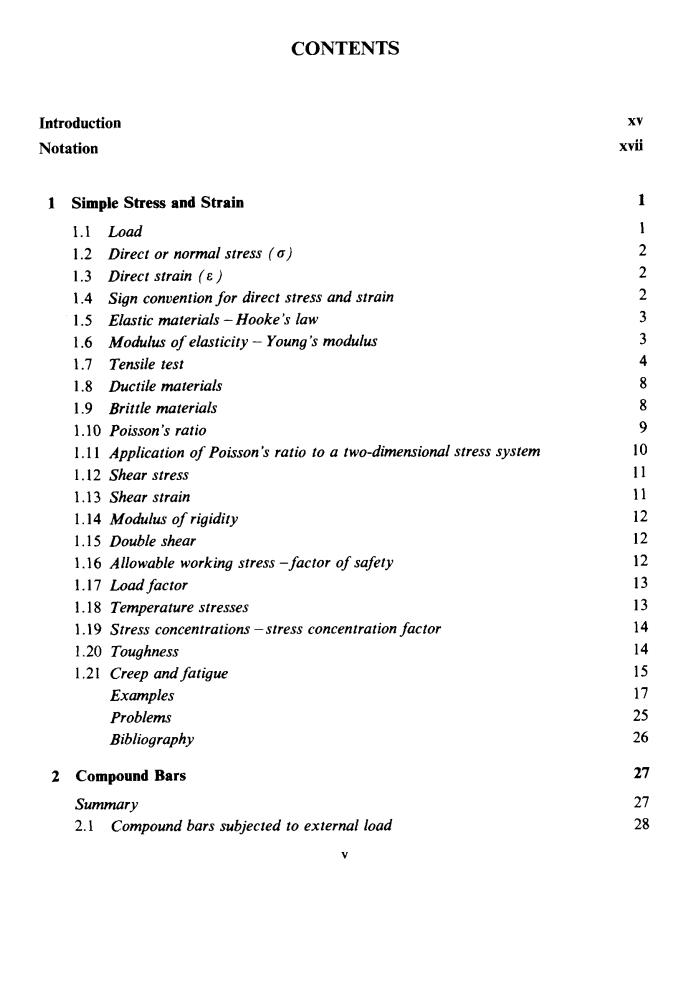
CONTENTS Introduction XV Notation 1 Simple Stress and Strain 1 1.I Load 1 1.2 Direct or normal stress (a) 2 1.3 Direct strain (8) 2 1.4 Sign convention for direct stress and strain 2 1.5 Elastic materials-Hooke's law 3 1.6 Modulus of elasticity-Young's modulus 3 1.7 Tensile test 4 1.8 Ductile materials 8 1.9 Brittle materials 8 1.10 Poisson's ratio 9 1.11 Application of Poisson's ratio to a two-dimensional stress system 10 1.12 Shear stress 11 1.13 Shear strain 11 1.14 Modulus of rigidity 12 1.15 Double shear 12 1.16 Allowable working stress -factor of safety 12 1.17 Load factor 13 1.18 Temperature stresses 13 1.19 Stress concentrations-stress concentration factor 14 1.20 Toughness 14 1.21 Creep and fatigue 15 Examples 17 Problems 25 Bibliography 26 2 Compound Bars 27 Summary 27 2.1 Compound bars subjected to external load 28
CONTENTS Introduction Notation xv XVii 1 Simple Stress and Strain 1.1 Load 1.2 Direct or normal stress (a) 1.3 Direct strain (E ) 1.4 Sign convention for direct stress and strain 1.5 Elastic materials - Hooke’s law 1.6 Modulus of elasticity - Young’s modulus 1.7 Tensile test 1.8 Ductile materials 1.9 Brittle materials 1.10 Poisson’s ratio 1.1 1 Application of Poisson’s ratio to a two-dimensional stress system 1.12 Shear stress 1.1 3 Shear strain 1.14 Modulus of rigidity 1,15 Double shear 1.16 Allowable working stress -factor of safety 1.17 Load factor 1.18 Temperature stresses 1.19 Stress concentrations -stress concentration factor 1.20 Toughness 1.21 Creep and fatigue Examples Problems Bibliography 2 Compound Bars Summary 2.1 Compound bars subjected to external load V 1 1 2 2 2 3 3 4 8 8 9 10 11 11 12 12 12 13 13 14 14 15 17 25 26 27 27 28
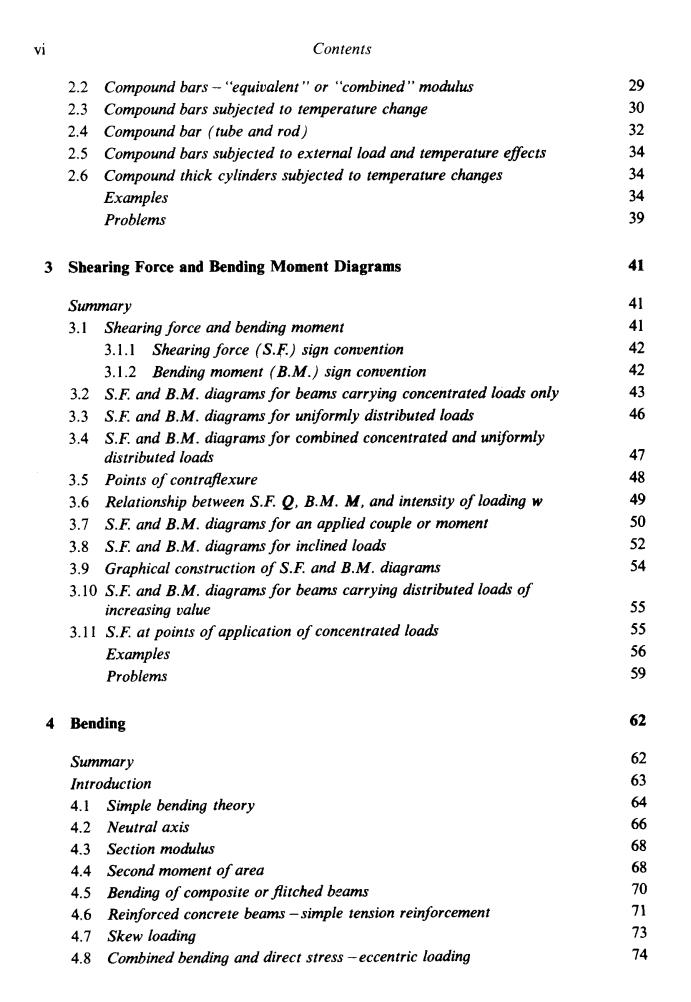
vi Contents 2.2 Compound bars-"equivalent"or "combined"modulus 29 2.3 Compound bars subjected to temperature change 30 2.4 Compound bar (tube and rod) 32 2.5 Compound bars subjected to external load and temperature effects 34 2.6 Compound thick cylinders subjected to temperature changes 34 Examples 4 Problems 3 Shearing Force and Bending Moment Diagrams 41 Summary 41 3.1 Shearing force and bending moment 41 3.1.1 Shearing force (S.F.)sign convention 42 3.1.2 Bending moment (B.M.)sign convention 42 3.2 S.F.and B.M.diagrams for beams carrying concentrated loads only 43 3.3 S.F.and B.M.diagrams for uniformly distributed loads 46 3.4 S.F.and B.M.diagrams for combined concentrated and uniformly distributed loads 47 3.5 Points of contraflexure 48 3.6 Relationship between S.F.O,B.M.M,and intensity of loading w 49 3.7 S.F.and B.M.diagrams for an applied couple or moment 50 3.8 S.F.and B.M.diagrams for inclined loads 52 3.9 Graphical construction of S.F.and B.M.diagrams 54 3.10 S.F.and B.M.diagrams for beams carrying distributed loads of increasing value 55 3.11 S.F.at points of application of concentrated loads 55 Examples 56 Problems 59 4 Bending 62 Summary 62 Introduction 63 4.1 Simple bending theory 64 4.2 Neutral axis 66 4.3 Section modulus 68 4.4 Second moment of area 68 4.5 Bending of composite or flitched beams 70 4.6 Reinforced concrete beams-simple tension reinforcement 71 4.7 Skew loading 73 4.8 Combined bending and direct stress-eccentric loading 74
vi Contents 2.2 Compound bars - ‘<equivalent ” or “combined” modulus 2.3 Compound bars subjected to temperature change 2.4 Compound bar (tube and rod) 2.5 Compound bars subjected to external load and temperature effects 2.6 Compound thick cylinders subjected to temperature changes Examples Problems 3 Shearing Force and Bending Moment Diagrams Summary 3.1 Shearing force and bending moment 3.1.1 Shearing force (S.F.) sign convention 3.1.2 Bending moment (B.M.) sign convention 3.2 S.F. and B.M. diagrams for beams carrying concentrated loads only 3.3 S.F. and B.M. diagrams for uniformly distributed loads 3.4 S.F. and B.M. diagrams for combined concentrated and uniformly distributed loads 3.5 Points of contrafexure 3.6 Relationship between S.F. Q, B.M. M, and intensity of loading w 3.1 S.F. and B.M. diagrams for an applied couple or moment 3.8 S.F. and B.M. diagrams for inclined loa& 3.9 Graphical construction of S.F. and B.M. diagrams 3.10 S.F. and B.M. diagrams for beams carrying distributed loads of increasing value 3.1 1 S.F. at points of application of concentrated loads Examples Problems 4 Bending Summary Introduction 4.1 Simple bending theory 4.2 Neutral axis 4.3 Section modulus 4.4 Second moment of area 4.5 4.6 4.1 Skew loading 4.8 Bending of composite or fitched beams Reinforced concrete beams -simple tension reinforcement Combined bending and direct stress -eccentric loading 29 30 32 34 34 34 39 41 41 41 42 42 43 46 47 48 49 50 52 54 55 55 56 59 62 62 63 64 66 68 68 70 71 73 74

Contents vii 4.9 "Middle-quarter"and "middle-third"rules 76 4.10 Shear stresses owing to bending 77 4.11 Strain energy in bending 78 4.12 Limitations of the simple bending theory 78 Examples 79 Problems 88 5 Slope and Deflection of Beams 92 Summary Introduction 9 5.1 Relationship between loading,S.F.,B.M.,slope and deflection 94 5.2 Direct integration method 97 5.3 Macaulay's method 102 5.4 Macaulay's method for u.d.I's 105 5.5 Macaulay's method for beams with u.d.1.applied over part of the beam 106 5.6 Macaulay's method for couple applied at a point 106 5.7 Mohr's "area-moment"method 108 5.8 Principle of superposition 112 5.9 Energy method 112 5.10 Maxwell's theorem of reciprocal displacements 112 5.11 Continuous beams-Clapeyron's "three-moment"equation 115 5.12 Finite difference method 118 5.13 Deflections due to temperature effects 119 Examples 123 Problems 138 6 Built-in Beams 140 Summary 140 Introduction 141 6.1 Built-in beam carrying central concentrated load 141 6.2 Built-in beam carrying uniformly distributed load across the span 142 6.3 Built-in beam carrying concentrated load offset from the centre 143 6.4 Built-in beam carrying a non-uniform distributed load 145 6.5 Advantages and disadvantages of built-in beams 146 6.6 Effect of movement of supports 146 Examples 147 Problems 152
Contents vii 4.9 4.10 Shear stresses owing to bending 4.1 1 Strain energy in bending 4.12 Limitations of the simple bending theory “Middle-quarter ” and “middle-third ” rules Examples Problems 5 Slope and Deflection of Beams Summary Introduction 5.1 5.2 Direct integration method 5.3 MacaulayS method 5.4 Macaulay’s method for u.d.ls 5.5 Macaulay’s method for beams with u.d.1. applied over part of the beam 5.6 Macaulay’s method for couple applied at a point 5.7 Mohr’s “area-moment” method 5.8 Principle of superposition 5.9 Energy method 5.10 Maxwell’s theorem of reciprocal displacements 5.1 1 Continuous beams - CIapeyron’s “three-moment ” equation 5.12 Finite difference method 5.13 Defections due to temperature effects Relationship between loading, S.F., B.M., slope and akfection Examples Problems 6 Built-in Beams Summary Introduction 6.1 Built-in beam carrying central concentrated load 6.2 Built-in beam carrying uniformly distributed load across the span 6.3 Built-in beam carrying concentrated load offset from the centre 6.4 Built-in beam carrying a non-uniform distributed load 6.5 Advantages and disadvantages of built-in beams 6.6 Effect of movement of supports Examples Problems 76 77 78 78 79 88 92 92 94 94 97 102 105 106 106 108 112 112 112 115 118 119 123 138 140 140 141 141 142 143 145 146 146 147 152
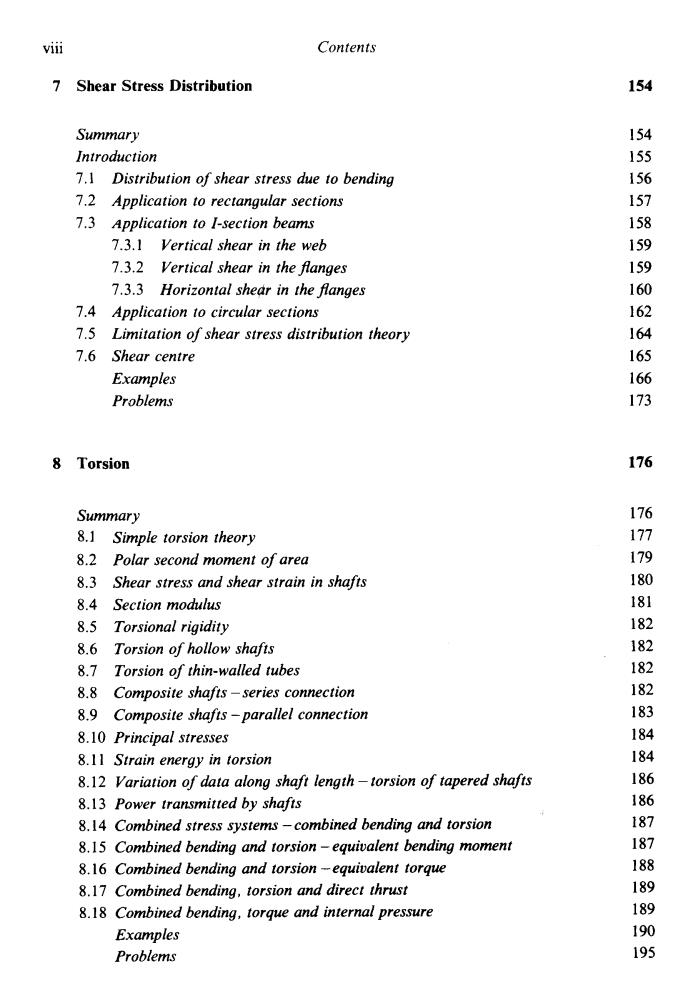
viii Contents 7 Shear Stress Distribution 154 Summary 154 Introduction 155 7.1 Distribution of shear stress due to bending 156 7.2 Application to rectangular sections 157 7.3 Application to I-section beams 158 7.3.1 Vertical shear in the web 159 7.3.2 Vertical shear in the flanges 159 7.3.3 Horizontal shear in the flanges 160 7.4 Application to circular sections 162 7.5 Limitation of shear stress distribution theory 164 7.6 Shear centre 165 Examples 166 Problems 173 8 Torsion 176 Summary 176 8.1 Simple torsion theory 177 8.2 Polar second moment of area 179 8.3 Shear stress and shear strain in shafts 180 8.4 Section modulus 181 8.5 Torsional rigidity 182 8.6 Torsion of hollow shafts 182 8.7 Torsion of thin-walled tubes 182 8.8 Composite shafts-series connection 182 8.9 Composite shafts-parallel connection 183 8.10 Principal stresses 184 8.11 Strain energy in torsion 184 8.12 Variation of data along shaft length-torsion of tapered shafts 186 8.13 Power transmitted by shafts 186 8.14 Combined stress systems-combined bending and torsion 187 8.15 Combined bending and torsion-equivalent bending moment 187 8.16 Combined bending and torsion-equivalent torque 188 8.17 Combined bending,torsion and direct thrust 189 8.18 Combined bending,torque and internal pressure 189 Examples 190 Problems 195
Contents ... Vlll 7 Shear Stress Distribution Summary Introduction 7.1 7.2 7.3 7.4 7.5 7.6 Distribution of shear stress due to bending Application to rectangular sections Application to I-section beams 7.3.1 Vertical shear in the web 7.3.2 Vertical shear in the flanges 7.3.3 Horizontal she& in the flanges Application to circular sections Limitation of shear stress distribution theory Shear centre Examples Problems 8 Torsion Summary 8.1 Simple torsion theory 8.2 Polar second moment of area 8.3 Shear stress and shear strain in shafts 8.4 Section modulus 8.5 Torsional rigidity 8.6 Torsion of hollow shafts 8.7 Torsion of thin-walled tubes 8.8 Composite shafts -series connection 8.9 Composite shafts -parallel connection 8.10 Principal stresses 8.1 1 Strain energy in torsion 8.12 Variation of data along shaft length -torsion of tapered shafts 8.13 Power transmitted by shafts 8,14 Combined stress systems -combined bending and torsion 8.15 Combined bending and torsion - equivalent bending moment 8.16 Combined bending and torsion -equivalent torque 8.17 Combined bending, torsion and direct thrust 8.18 Combined bending, torque and internal pressure Examples Problems 154 154 155 156 157 158 159 159 160 162 164 165 166 173 176 176 177 179 180 181 182 182 182 182 183 184 184 186 186 187 187 188 189 189 190 195
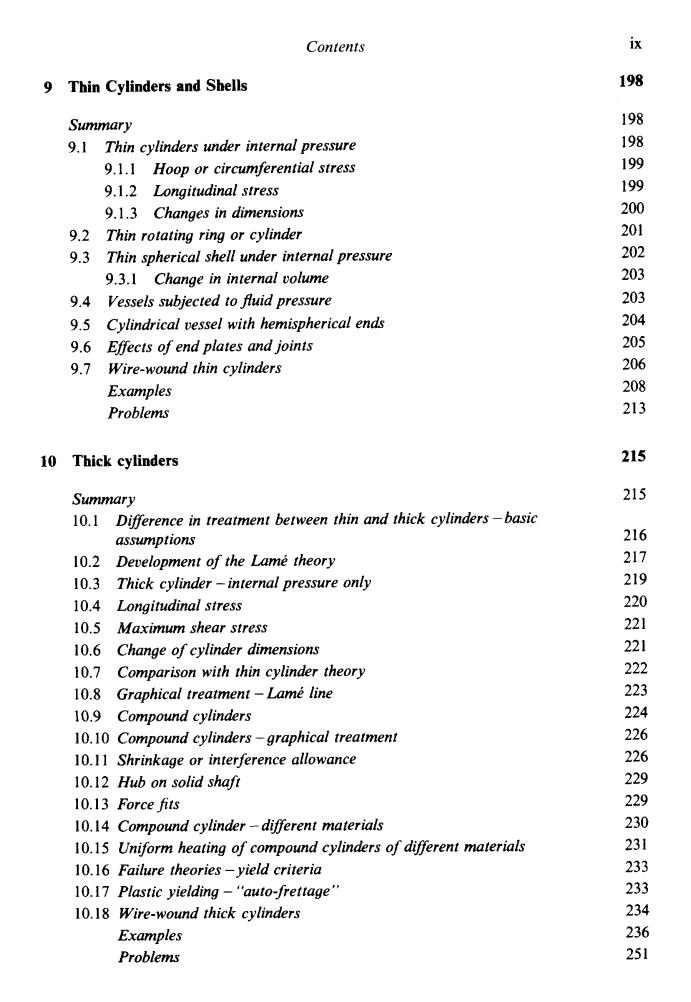
Contents ix 9 Thin Cylinders and Shells 198 Summary 198 9.1 Thin cylinders under internal pressure 198 9.1.1 Hoop or circumferential stress 199 9.1.2 Longitudinal stress 199 9.1.3 Changes in dimensions 200 9.2 Thin rotating ring or cylinder 201 9.3 Thin spherical shell under internal pressure 202 9.3.1 Change in internal volume 203 9.4 Vessels subjected to fluid pressure 203 9.5 Cylindrical vessel with hemispherical ends 204 9.6 Effects of end plates and joints 205 9.7 Wire-wound thin cylinders 206 Examples 208 Problems 213 10 Thick cylinders 215 Summary 215 10.1 Difference in treatment between thin and thick cylinders-basic assumptions 216 10.2 Development of the Lame theory 217 10.3 Thick cylinder -internal pressure only 219 10.4 Longitudinal stress 220 10.5 Maximum shear stress 221 10.6 Change of cylinder dimensions 221 10.7 Comparison with thin cylinder theory 222 10.8 Graphical treatment-Lame line 10.9 Compound cylinders 224 10.10 Compound cylinders-graphical treatment 10.11 Shrinkage or interference allowance 10.12 Hub on solid shaft 10.13 Force fits 229 10.14 Compound cylinder-different materials 10.15 Uniform heating of compound cylinders of different materials 231 10.16 Failure theories-yield criteria 233 10.17 Plastic yielding-"auto-frettage" 233 10.18 Wire-wound thick cylinders 234 Examples 236 Problems 251
Contents 9 Thin Cylinders and Shells ix 198 Summary 9.1 Thin cylinders under internal pressure 9.1.1 Hoop or circumferential stress 9.1.2 Longitudinal stress 9.1.3 Changes in dimensions Thin rotating ring or cylinder Thin spherical shell under internal pressure 9.3.1 Change in internal volume Vessels subjected to JIuid pressure Cylindrical vessel with hemispherical end Effects of end plates and joints Examples Problems 9.2 9.3 9.4 9.5 9.6 9.7 Wire-wound thin cylinders 10 Thick cylinders Summary 10.1 10.2 10.3 10.4 Longitudinal stress 10.5 Maximum shear stress 10.6 Change of cylinder dimensions 10.7 10.8 10.9 Compound cylinders 10.10 Compound cylinders -graphical treatment 10.1 1 Shrinkage or interference allowance 10.12 Hub on solid shaji 10.13 Force fits 10.14 Compound cylinder -different materials 10.15 Uniform heating of compound cylinders of different materials 10.16 Failure theories -yield criteria 10.17 Plastic yielding - “auto-frettage” 10.18 Wire-wound thick cylinders Difference in treatment between thin and thick cylinders -basic assumptions Development of the Lame theory Thick cylinder - internal pressure only Comparison with thin cylinder theory Graphical treatment - Lame line Examples Problems 198 198 199 199 200 20 1 202 203 203 204 205 206 208 213 215 215 216 217 219 220 22 1 22 1 222 223 224 226 226 229 229 230 23 1 233 233 234 236 25 1

Contents 11 Strain Energy 254 Summary 254 Introduction 256 11.1 Strain energy-tension or compression 257 11.2 Strain energy-shear 259 11.3 Strain energy-bending 260 11.4 Strain energy-torsion 261 11.5 Strain energy of a three-dimensional principal stress system 262 11.6 Volumetric or dilatational strain energy 262 11.7 Shear or distortional strain energy 263 11.8 Suddenly applied loads 263 11.9 Impact loads-axial load application 264 11.10 Impact loads-bending applications 265 11.11 Castigliano's first theorem for deflection 266 11.12 "Unit-load"method 268 11.13 Application of Castigliano's theorem to angular movements 269 11.14 Shear deflection 269 Examples 274 Problems 292 12 Springs 297 Summary 297 Introduction 299 12.1 Close-coiled helical spring subjected to axial load W 299 12.2 Close-coiled helical spring subjected to axial torque T 300 12.3 Open-coiled helical spring subjected to axial load W 301 12.4 Open-coiled helical spring subjected to axial torque T 304 12.5 Springs in series 305 12.6 Springs in parallel 306 12.7 Limitations of the simple theory 306 12.8 Extension springs-initial tension 307 12.9 Allowable stresses 308 12.10 Leaf or carriage spring:semi-elliptic 309 12.11 Leaf or carriage spring:quarter-elliptic 312 12.12 Spiral spring 314 Examples 316 Problems 324
X Contents 11 Strain Energy 254 Summary Introduction 1 1.1 1 1.2 Strain energy -shear 1 1.3 Strain energy -bending 1 1.4 Strain energy - torsion 1 1.5 Strain energy of a three-dimensional principal stress system 1 1.6 Volumetric or dilatational strain energy 1 1.7 Shear or distortional strain energy 1 1.8 Suddenly applied loads 1 1.9 Impact loads -axial load application 1 1.10 Impact loads -bending applications 1 1.1 1 Castigliano’s first theorem for deflection 1 1.12 “Unit-load ” method 1 1.13 Application of Castigliano ’s theorem to angular movements 1 1.14 Shear deflection Examples Problems Strain energy - tension or compression 12 Springs Summary Introduction 12.1 Close-coiled helical spring subjected to axial load W 12.2 Close-coiled helical spring subjected to axial torque T 12.3 Open-coiled helical spring subjected to axial load W 12.4 Open-coiled helical spring subjected to axial torque T 12.5 Springs in series 12.6 Springs in parallel 12.7 12.8 12.9 Allowable stresses 12.10 Leaf or carriage spring: semi-elliptic 12.1 1 Leaf or carriage spring: quarter-elliptic 12.12 Spiral spring Limitations of the simple theory Extension springs - initial tension Examples Problems 254 256 257 259 260 26 1 262 262 263 263 264 265 266 268 269 269 274 292 297 297 299 299 300 30 1 304 305 306 306 307 308 309 312 314 316 324

Contents xi 13 Complex Stresses 326 Summary 326 13.1 Stresses on oblique planes 326 13.2 Material subjected to pure shear 327 13.3 Material subjected to two mutually perpendicular direct stresses 329 13.4 Material subjected to combined direct and shear stresses 329 13.5 Principal plane inclination in terms of the associated principal stress 331 13.6 Graphical solution-Mohr's stress circle 332 13.7 Alternative representations of stress distributions at a point 334 13.8 Three-dimensional stresses-graphical representation 338 Examples 342 Problems 358 14 Complex Strain and the Elastic Constants 361 Summary 361 14.1 Linear strain for tri-axial stress state 361 14.2 Principal strains in terms of stresses 362 14.3 Principal stresses in terms of strains-two-dimensional stress system 363 14.4 Bulk modulus K 363 14.5 Volumetric strain 363 14.6 Volumetric strain for unequal stresses 364 14.7 Change in volume of circular bar 365 14.8 Effect of lateral restraint 366 14.9 Relationship between the elastic constants E,G.K and v 367 14.10 Strains on an oblique plane 370 14.11 Principal strain-Mohr's strain circle 372 14.12 Mohr's strain circle-alternative derivation from the general stress equations 374 14.13 Relationship between Mohr's stress and strain circles 375 14.14 Construction of strain circle from three known strains (McClintock method)-rosette analysis 378 14.15 Analytical determination of principal strains from rosette readings 381 14.16 Alternative representations of strain distributions at a point 383 14.17 Strain energy of three-dimensional stress system 385 Examples 387 Problems 397 15 Theories of Elastic Failure 401 Summary 401 Introduction 401
Con tents 13 Complex Stresses Summary 1 3.1 Stresses on oblique planes 13.2 Material subjected to pure shear 13.3 Material subjected to two mutually perpendicular direct stresses 13.4 Material subjected to combined direct and shear stresses 13.5 Principal plane inclination in terms of the associated principal stress 13.6 Graphical solution - Mohr 's stress circle 13.7 Alternative representations of stress distributions at a point 1 3.8 Three-dimensional stresses -graphical representation Examples Problems xi 326 326 326 327 329 329 33 1 332 334 338 342 358 14 Complex Strain and the Elastic Constants Summary 14.1 Linear strain for tri-axial stress state 14.2 Principal strains in terms of stresses 14.3 Principal stresses in terms of strains -two-dimensional stress system 14.4 Bulk modulus K 14.5 Volumetric strain 14.6 14.1 14.8 Effect of lateral restraint 14.9 14.10 Strains on an oblique plane 14.1 1 Principal strain - Mohr s strain circle 14.12 Mohr 's strain circle -alternative derivation from the 14.13 Relationship between Mohr 's stress and strain circles 14.14 Construction of strain circle from three known strains 14.15 Analytical determination of principal strains from rosette readings 14.16 Alternative representations of strain distributions at a point 14.1 I Strain energy of three-dimensional stress system Volumetric strain for unequal stresses Change in volume of circular bar Relationship between the elastic constants E, G, K and v general stress equations (McClintock method) -rosette analysis Examples Problems 361 36 1 36 1 362 363 363 363 364 365 366 361 310 312 3 74 375 318 38 1 383 385 387 397 15 Theories of Elastic Failure 401 Summary Introduction 401 40 1
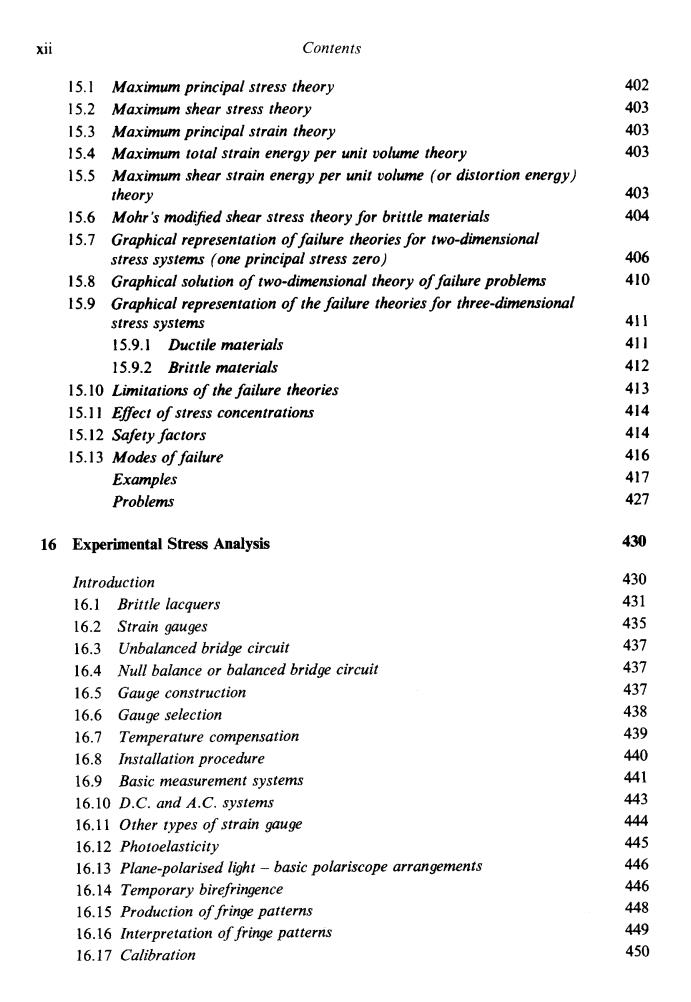
xii Contents 15.1 Maximum principal stress theory 402 15.2 Maximum shear stress theory 403 15.3 Maximum principal strain theory 403 15.4 Maximum total strain energy per unit volume theory 403 15.5 Maximum shear strain energy per unit volume (or distortion energy) theory 403 15.6 Mohr's modified shear stress theory for brittle materials 404 15.7 Graphical representation of failure theories for two-dimensional stress systems (one principal stress zero) 406 15.8 Graphical solution of two-dimensional theory of failure problems 410 15.9 Graphical representation of the failure theories for three-dimensional stress systems 41I 15.9.1 Ductile materials 411 15.9.2 Brittle materials 412 15.10 Limitations of the failure theories 413 15.11 Effect of stress concentrations 414 15.12 Safety factors 414 15.13 Modes of failure 416 Examples 417 Problems 427 16 Experimental Stress Analysis 430 Introduction 430 16.1 Brittle lacquers 431 16.2 Strain gauges 435 16.3 Unbalanced bridge circuit 437 16.4 Null balance or balanced bridge circuit 437 16.5 Gauge construction 437 16.6 Gauge selection 438 16.7 Temperature compensation 439 16.8 Installation procedure 440 16.9 Basic measurement systems 441 16.10 D.C.and A.C.systems 443 16.11 Other types of strain gauge 444 16.12 Photoelasticity 445 16.13 Plane-polarised light-basic polariscope arrangements 446 16.14 Temporary birefringence 446 16.15 Production of fringe patterns 448 16.16 Interpretation of fringe patterns 449 16.17 Calibration 450
xii Contents 15.1 15.2 15.3 15.4 15.5 15.6 15.7 15.8 15.9 Maximum principal stress theory Maximum shear stress theory Maximum principal strain theory Maximum total strain energy per unit volume theory Maximum shear strain energy per unit volume (or distortion energy) theory Mohr 's modijied shear stress theory for brittle materials Graphical representation of failure theories for two-dimensional stress systems (one principal stress zero) Graphical solution of two-dimensional theory of failure problems Graphical representation of the failure theories for three-dimensional stress systems 15.9.1 Ductile materials 15.9.2 Brittle materials 15.10 Limitations of the failure theories 15.1 1 Eflect of stress concentrations 15.12 Safety factors 15.13 Modes of failure Examples Problems 16 Experimental Stress Analysis Introduction 16.1 Brittle lacquers 16.2 Strain gauges 16.3 Unbalanced bridge circuit 16.4 Null balance or balanced bridge circuit 16.5 Gauge construction 16.6 Gauge selection 16.7 Temperature compensation 16.8 Installation procedure 16.9 Basic measurement systems 16.10 D.C. and A.C. systems 16.11 Other types of strain gauge 16.12 Photoelasticity 16.13 Plane-polarised light - basic polariscope arrangements 16.14 Temporary birefringence 16.15 Production of fringe patterns 16.16 Interpretation of fringe patterns 16.17 Calibration 402 403 403 403 403 404 406 410 41 1 41 1 412 41 3 414 414 41 6 417 427 430 430 43 1 43 5 437 437 437 438 439 440 441 443 444 445 446 446 448 449 450
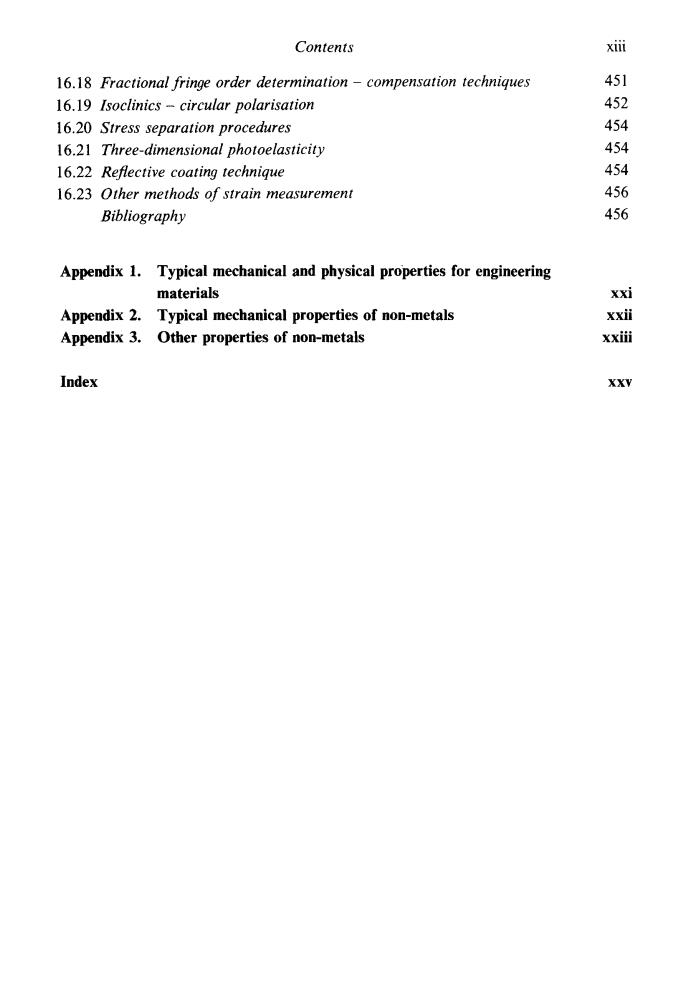
Contents xiii 16.18 Fractional fringe order determination-compensation techniques 451 16.19 Isoclinics-circular polarisation 452 16.20 Stress separation procedures 454 16.21 Three-dimensional photoelasticity 454 16.22 Reflective coating technique 454 16.23 Other methods of strain measurement 456 Bibliography 456 Appendix 1.Typical mechanical and physical properties for engineering materials xxi Appendix 2.Typical mechanical properties of non-metals xxii Appendix 3.Other properties of non-metals xxiii Index XXV
Contents xiii 16.18 Fractional fringe order determination - compensation techniques 16.19 Isoclinics - circular polarisation 16.20 Stress separation procedures 16.21 Three-dimensional photoelasticity 16.22 Reflective coating technique 16.23 Other methods of strain measurement Bibliography Appendix 1. Typical mechanical and physical pro'prties for engineering materials Appendix 2. Typical mechanical properties of non-metals Appendix 3. Other properties of non-metals 45 1 452 454 454 454 456 456 xxi xxii xxiii Index xxv